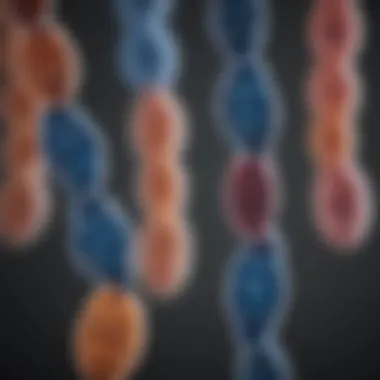Exploring Chromosomes 13, 18, and 21: Variations and Impact


Article Overview
Purpose of the Article
This article aims to provide a detailed examination of chromosomes 13, 18, and 21, focusing on their structure, function, and significance in human genetics. Understanding these chromosomes is essential not only for students and researchers but also for clinicians and educators. Recognizing the implications of chromosomal variations is vital for advancing medical knowledge and enhancing healthcare outcomes.
Relevance to Multiple Disciplines
The relevance of chromosomes 13, 18, and 21 extends across various fields, including genetics, medicine, and biology. In genetics, these chromosomes are studied to understand their roles in hereditary diseases. In the medical field, practitioners and researchers analyze the abnormalities associated with them to develop better diagnostics and treatments. Moreover, educators can utilize this knowledge to foster a deeper understanding of genetics among students, creating an informed public regarding genetic disorders.
Research Background
Historical Context
The study of chromosomes has a rich history, dating back to the late 19th century when the chromosome theory of inheritance was formulated. Chromosomes 13, 18, and 21 were identified as pivotal in the study of human genetics due to their link to several genetic disorders. For instance, Down syndrome is associated with chromosome 21, while abnormalities in chromosome 18 and 13 have implications in other serious health conditions. Research has evolved significantly from simple microscopy to advanced genetic sequencing techniques.
Key Concepts and Definitions
To grasp the essence of this article, certain key concepts should be defined:
- Chromosome: A thread-like structure located within the nucleus of animal and plant cells, containing DNA.
- Abnormality: A deviation from the normal structure or function of a chromosome, which can lead to genetic disorders.
- Genetic Disorder: A condition caused by abnormalities in an individual's DNA, often inherited or arising from mutations.
Understanding these terms is foundational for delving deeper into the analysis of chromosomes 13, 18, and 21, and their impact on human health and development.
"Chromosomal abnormalities in chromosomes 13, 18, and 21 are critical to understanding various genetic conditions and their management across disciplines."
"Chromosomal abnormalities in chromosomes 13, 18, and 21 are critical to understanding various genetic conditions and their management across disciplines."
As we proceed, the overview provided will usher us into the detailed exploration of these chromosomes, their functions, and the implications of their variations on health.
Prologue to Human Chromosomes
Human chromosomes are fundamental entities that play an essential role in genetics. They are structures composed of DNA and protein, which carry genetic information crucial for the development, functioning, and reproduction of an organism. The topic of human chromosomes is vital as it unveils the complexities of genetic inheritance and variation. These variations are not merely scientific curiosities; they have profound implications for health, disease, and understanding human biological diversity.
In this article, we will detail three specific chromosomes—Chromosomes 13, 18, and 21. Focusing on these chromosomes aids in dissecting their structure, function, and the common abnormalities associated with them. Understanding these aspects is particularly important for students, researchers, and medical professionals. Familiarity with chromosomal variations can enhance diagnostic precision and inform treatment strategies for various genetic disorders.
Overview of Chromosomal Structure
Chromosomes are organized into a compact structure that allows them to efficiently package and manage genetic information. Each chromosome consists of two sister chromatids joined at a region known as the centromere. The DNA is coiled around histone proteins, forming nucleosomes which further coil and fold to create the overall structure.
Chromosomes come in pairs—one inherited from each parent. Humans typically have 23 pairs, totaling 46 chromosomes. Chromosomes are classified into two categories: autosomes and sex chromosomes. Autosomes are the first 22 pairs, while the 23rd pair determines the biological sex (XX for females and XY for males).
In particular, Chromosomes 13, 18, and 21 fall within the group of autosomes and contain a wealth of genetic information that is critical for various bodily functions. Understanding the layout of these chromosomes helps in identifying specific loci associated with certain traits and conditions.
Importance of Chromosomal Function
The function of chromosomes is equally important as their structure. Chromosomes are the vehicles of heredity; they carry genes that dictate everything from physical traits to susceptibility to diseases. Genes are segments of DNA that encode instructions for building proteins, which perform most life functions.
Each chromosome plays a specific role in processes such as cell division, DNA replication, and gene expression. Any disruptions in these functions can lead to genetic disorders. For instance, abnormalities in Chromosome 21 are famously linked to Down syndrome, a condition caused by an extra copy of this chromosome.
"Chromosomal abnormalities can lead to serious health issues, underscoring the need for thorough genetic analysis."
"Chromosomal abnormalities can lead to serious health issues, underscoring the need for thorough genetic analysis."
In the context of Chromosomes 13, 18, and 21, studying their functions not only sheds light on their roles in health and disease but also paves the way for advancements in genetic research. Being equipped with this knowledge helps professionals devise targeted therapies and consider genetic counseling for those affected by chromosomal disorders.
Specific Chromosome Analysis
The detailed analysis of specific chromosomes is crucial in understanding the broader context of human genetics. Each chromosome carries distinct genetic information and plays unique roles in development and health. In this article, we examine chromosomes 13, 18, and 21, exploring their structure, function, and implications for genetic disorders.


Focusing on individual chromosomes allows researchers and medical professionals to identify abnormal variations that can lead to specific health issues. By studying these variations, we can develop targeted management strategies. Additionally, this analysis aids in genetic counseling, helping individuals and families understand their risks for conditions linked with these chromosomes.
Chromosome 13: Structure and Function
Chromosome 13 is notably one of the larger human chromosomes, comprising approximately 114 million base pairs. It carries more than 400 genes and houses essential regions, including the retinoblastoma gene, which is critical for regulating cell growth. The overall structure of chromosome 13 is organized into distinct regions, consisting of the short arm (p) and the long arm (q).
Functionally, chromosome 13 is linked to several biological processes. Its genes are involved in the development of various tissues and the regulation of cellular processes. Mutations or abnormalities in chromosome 13 can lead to several conditions, such as retinoblastoma and certain congenital disorders.
Chromosome 18: Key Features
Chromosome 18 is smaller than chromosome 13, containing about 76 million base pairs and approximately 300 genes. Key features of this chromosome include regions involved in crucial functions related to cellular signaling and development. Genes located on chromosome 18 are associated with heart and bone development, among other functions.
Aberrations in chromosome 18 can have significant implications. For example, disorders like Edwards syndrome, caused by trisomy of this chromosome, can result in severe developmental and health issues. This chromosome is also characterized by important cytogenetic features that can be used in clinical diagnosis.
Chromosome 21: Significance in Genetics
Chromosome 21 is known for its critical role in various genetic disorders. With about 48 million base pairs, it is the smallest human chromosome. It contains about 200 genes, many of which are involved in cognitive development and other essential brain functions. The most well-known condition associated with chromosome 21 is Down syndrome, which results from an extra copy of this chromosome.
The significance of chromosome 21 extends beyond Down syndrome. Research into this chromosome has opened inquiries into the genetic basis of other cognitive and physical disabilities. Understanding the function and abnormalities of chromosome 21 is thus essential in the context of genetics, as it helps articulate the complex relationships between genes and health.
Common Chromosomal Abnormalities
Understanding common chromosomal abnormalities is crucial for both clinical practice and ongoing research. These abnormalities can have significant effects on human health, often influencing developmental processes, susceptibility to various diseases, and overall biological function. This section will explore overarching themes surrounding chromosomal disorders and specifically investigate aberrations linked to chromosomes 13, 18, and 21. By examining these variances, we can appreciate the depth of genetic diversity and its implications.
Overview of Chromosomal Disorders
Chromosomal disorders arise from abnormalities in chromosome number or structure. They can be broadly classified into two categories: numerical abnormalities and structural abnormalities. Numerical abnormalities occur when there are too many or too few chromosomes. This can lead to conditions like Down syndrome, which is caused by an extra copy of chromosome 21. On the other hand, structural abnormalities involve changes in the physical structure of chromosomes, such as deletions, duplications, inversions, or translocations. Understanding these disorders is critical for genetic counseling and managing health risks.
"The study of chromosomal disorders remains a vital area in genetics, with implications that reach far beyond simple numbers."
"The study of chromosomal disorders remains a vital area in genetics, with implications that reach far beyond simple numbers."
Aberrations of Chromosome
Chromosome 13 is known to harbor several critical genes. Aberrations in this chromosome can result in various disorders, including Patau syndrome. This chromosomal condition is characterized by the presence of an additional chromosome 13, leading to significant physical and intellectual disabilities. Individuals with Patau syndrome often exhibit severe developmental challenges and are at high risk of life-threatening conditions.
Furthermore, deletions on chromosome 13 can lead to retinoblastoma, a rare form of childhood cancer. The loss of genetic material in this region impacts tumor suppression. Close monitoring and genetic testing are sometimes recommended for families with a history of such disorders.
Aberrations of Chromosome
Chromosome 18 is less discussed, yet its abnormalities are also significant. One of the major disorders associated with this chromosome is Edwards syndrome or trisomy 18. It occurs due to an extra chromosome 18, leading to a range of complications. These complications often include congenital heart defects, growth delays, and distinct physical features such as clenched fists.
Children with Edwards syndrome have a lower survival rate, which emphasizes the need for awareness and prenatal diagnosis. Genetic testing can help identify potential risks and provide families with guidance and options.
Aberrations of Chromosome
Chromosome 21 is primarily recognized for its connection to Down syndrome. This disorder results from an additional chromosome 21, known as trisomy 21. Individuals with Down syndrome often face developmental delays, characteristic facial features, and increased chances of certain health issues, such as heart defects and gastrointestinal problems.
Besides Down syndrome, structural abnormalities involving chromosome 21 can also lead to various health challenges. These include changes such as translocations, which could contribute to leukemia in younger patients. Identifying these abnormalities early helps in managing and treating associated health issues effectively.
Clinical Implications of Chromosomal Variations
Understanding the clinical implications of chromosomal variations is crucial for multiple reasons. First, these variations often lead to significant health challenges. Identifying the effects of abnormalities on chromosomes 13, 18, and 21 helps in early diagnosis and potential interventions. Clinicians can better manage patient care and outline treatment plans effectively. Furthermore, this knowledge facilitates genetic counseling, allowing families to make informed decisions based on potential risks associated with these chromosomal conditions.
Impact of Chromosome Abnormalities
Associated Conditions
Chromosome 13 abnormalities are associated with conditions such as Patau syndrome and certain types of cancers. Patau syndrome results from trisomy 13, which involves severe intellectual disability and physical abnormalities. This condition illustrates the severe outcomes that can arise from chromosomal variants. Understanding these associated conditions emphasizes the need for enhanced awareness and screening methods for affected individuals.
In addition to direct effects on health, these conditions underscore the importance of research to understand genetic predispositions to diseases linked to chromosomal abnormalities. This area of study could lead to groundbreaking treatments and therapies for those affected.


Management Strategies
Management strategies for abnormalities in chromosome 13 focus on supportive care and monitoring. Care plans often include a multidisciplinary team approach, addressing medical, psychological, and social needs. Individualized intervention is crucial, considering the unique challenges each patient faces based on their specific condition.
A strong characteristic of these strategies lies in their adaptability. With continuous research, management techniques evolve, providing better support options over time. This adaptability promotes effective treatment outcomes, potentially improving the quality of life for individuals affected.
Impact of Chromosome Abnormalities
Associated Conditions
Chromosome 18 abnormalities can lead to conditions such as Edwards syndrome, characterized by severe developmental delays. The effects of Edwards syndrome can include a small head, heart defects, and organ dysfunction. Such characteristics make this condition profoundly tragic and often fatal in infancy. Research in this area illuminates critical insights into genetic variations' impact on overall development and health.
The presence of associated conditions highlights why physicians must engage in proactive genetic assessments. Early diagnosis can help families access resources to manage these complex conditions and provide care tailored to the patient's needs.
Management Strategies
Management for chromosome 18 abnormalities often involves comprehensive care strategies. This may include cardiology, surgery for physical anomalies, and physical therapy for motor skill development. The unique feature of these management strategies is their focus on multi-faceted approaches that integrate various health care specialties.
Consequently, it enables continuous evaluation and adjustment based on the patient’s progress, providing a framework that adapts to evolving needs. Effective management can considerably affect the length and quality of life for individuals dealing with these abnormalities.
Impact of Chromosome Abnormalities
Associated Conditions
Chromosome 21 abnormalities are primarily linked to Down syndrome, resulting from an extra copy of this chromosome. Down syndrome leads to intellectual disabilities, characteristic facial features, and increased health risks. Awareness of these conditions is critical, as early intervention plays a vital role in enhancing development and interactions in children with Down syndrome.
Thus, the associated conditions represent broader implications, not just biological, but also societal. Understanding these impacts allows communities to foster inclusivity and support for affected individuals.
Management Strategies
Management strategies for patients with abnormalities on chromosome 21 include early intervention programs focusing on skill development and education tailored to individual learning needs. Furthermore, inclusion in early childhood education plays a crucial role. Early interventions can greatly enhance cognitive and motor skills development.
The uniqueness of this approach centers on collaboration among educators, health professionals, and families. Such collaboration promotes a well-rounded support system that nurtures growth.
This holistic management strategy exemplifies how targeted, well-coordinated care can facilitate advancements in the quality of life for individuals with chromosome 21 abnormalities.
This holistic management strategy exemplifies how targeted, well-coordinated care can facilitate advancements in the quality of life for individuals with chromosome 21 abnormalities.
End of Clinical Implications
Recent Research Developments
Research in the field of genetics is advancing rapidly, especially when it comes to understanding chromosomes and their variations. Chromosomes 13, 18, and 21 are significant due to their direct relationships with various genetic disorders. Recent findings in this area can profoundly impact diagnosis, management, and treatment strategies for affected individuals.
Advancements in Genetic Testing
Genetic testing has evolved into a systematic approach that identifies mutations associated with chromosomal abnormalities. Technologies like whole-genome sequencing and array comparative genomic hybridization improve accuracy in detecting genomic rearrangements.
- Benefits of Advancements:
- Early diagnosis of genetic disorders.
- Personalized treatment plans based on specific chromosomal information.
- Research opportunities leading to new therapeutic targets.
These technologies pave the way for opportunities in precision medicine, allowing healthcare providers to tailor interventions. As genetic testing becomes more accessible, monitoring health outcomes should also be improved.
Current Findings on Chromosome
Recent research focuses on the implications of abnormalities in chromosome 13, particularly deletions and duplications. Studies have identified a range of disorders linked to this chromosome. For instance, retinoblastoma is associated with losses in specific regions.
Additionally, scientists are exploring the roles of various genes within this chromosome in conditions such as Schizophrenia, emphasizing genetics' interplay with environmental factors. Understanding these connections can facilitate effective interventions for those at risk.
Current Findings on Chromosome


Chromosome 18, particularly its long arm (18q), exhibits crucial relevance in various genetic syndromes. Research shows that conditions like 18q deletion syndrome highlight developmental issues that arise due to genetic imbalances. Researchers are now investigating gene dosage effects and their impact on cognitive development.
- Notable aspects:
- Clinical features of 18q deletion syndrome include growth delays and learning disabilities.
- Early interventions can improve developmental outcomes.
Recent studies suggest that targeted therapy may become possible as knowledge expands in this area.
Current Findings on Chromosome
Chromosome 21 is well-known for its relevance to Down syndrome. Recent genomic studies provide insights into how gene dosage contributes to the phenotype of this condition. Understanding the specific genes that lead to the symptoms of Down syndrome can inform therapeutic strategies.
Moreover, researchers are also investigating gene-environment interactions influencing health outcomes in individuals affected by this chromosome. This comprehensive approach is vital for developing interventions that could mitigate associated challenges.
"The genetic landscape remains complex, and ongoing research is essential for enhancing our understanding of chromosomal variations and their societal implications."
"The genetic landscape remains complex, and ongoing research is essential for enhancing our understanding of chromosomal variations and their societal implications."
In summary, significant strides in genetic testing and current findings regarding chromosomes 13, 18, and 21 signal promising developments in genetic research. These advancements not only refine our knowledge but also enhance therapeutic strategies for managing conditions associated with these chromosomes.
Future Directions in Chromosomal Studies
The field of chromosomal studies is ever-evolving. Advances in research, technology, and understanding can greatly influence how we approach genetic variations. As we focus on chromosomes 13, 18, and 21, it is essential to discuss the future directions that may help clarify their role in human genetics. This exploration opens new avenues for research, ultimately improving diagnostic methods and therapeutic interventions.
Technological improvements and a deeper understanding of genetic variations will greatly enhance the assessment of chromosomal abnormalities. With increasing precision in genetic mapping, we can foresee substantial shifts in our handling of related disorders.
Emerging Technologies
Emerging technologies play a pivotal role in mapping chromosomal variations. Advanced methods like CRISPR-Cas9 gene editing, next-generation sequencing, and single-cell genomic technologies offer unprecedented insight into the intricate workings of genetic material. These technologies allow researchers to target specific genes linked with chromosomes 13, 18, and 21.
Key aspects include:
- CRISPR-Cas9: A revolutionary tool that enables precise editing of genetic sequences. It can potentially rectify genetic defects on chromosomes.
- Next-Generation Sequencing: Offers high-throughput sequencing capabilities, essential for understanding complex interactions between genes and their functions.
- Single-Cell Genomics: Assists in studying the genetic composition of individual cells, improving our understanding of cell heterogeneity and chromosomal behavior in diseases.
Emerging technologies are not just tools; they pave the path for innovative studies and breakthroughs in chromosomal research.
Sustainable Research Approaches
Research in chromosomal variations must be sustainable and ethical. As the scientific community progresses, the need for responsible research practices is more important than ever. An emphasis on collaboration among institutions can enhance the efficiency of research efforts.
Sustainable approaches should focus on the following:
- Interdisciplinary Collaborations: Combining expertise from genetics, bioinformatics, and clinical research can lead to more holistic insights.
- Public Engagement: Engaging with the community can improve awareness and foster support for genetic research initiatives.
- Transparency in Research: Open sharing of data and findings enhances reproducibility and credibility in the scientific community.
Sustaining research initiatives ensures that both ethical considerations and innovative advancements coexist. This balance will position future studies effectively within the broader context of human health.
"Future directions in chromosomal studies present significant opportunities to improve our understanding of genetic variations, contributing profoundly to both medical science and society."
"Future directions in chromosomal studies present significant opportunities to improve our understanding of genetic variations, contributing profoundly to both medical science and society."
The End
The conclusion serves as a vital component in any discussion on chromosomes, especially focusing on chromosomes 13, 18, and 21. It synthesizes the main points discussed throughout the article, providing clarity on the significance of chromosomal variations in human genetics. Key findings highlight the role these chromosomes play in various disorders and their relevance to clinical studies, research, and public awareness.
Summary of Findings and Implications
In summary, this article delves deeply into the structure and function of chromosomes 13, 18, and 21. It highlights specific abnormalities associated with these chromosomes—such as Down syndrome linked to chromosome 21 and Patau syndrome linked to chromosome 13. The implications of these findings extend beyond genetics into healthcare, emphasizing the necessity for ongoing research, early detection, and effective management strategies for associated conditions. The link between chromosomal variations and genetic disorders cannot be overstated; understanding these features not only aids in genetics but also informs patient care.
Final Thoughts on Chromosomes , , and
In conclusions, chromosomes 13, 18, and 21 are crucial in the broader context of human genetics. Enhanced knowledge of their structure, function, and the impact of chromosomal abnormalities fosters better diagnosis and management strategies for related disorders. As research progresses, particularly through emerging technologies, we can expect further insights into these chromosomal variations. This ongoing dialogue is essential for both the academic community and the general public, reinforcing the importance of genetics in understanding human health.
"Advancements in genetic testing and research pave the way for a deeper understanding of chromosomal variations and disorders."
"Advancements in genetic testing and research pave the way for a deeper understanding of chromosomal variations and disorders."
Thus, as we formulate future directions in the study of these chromosomes, the significance of chromosomes 13, 18, and 21 remain a focal point in enhancing human health and genetics.



